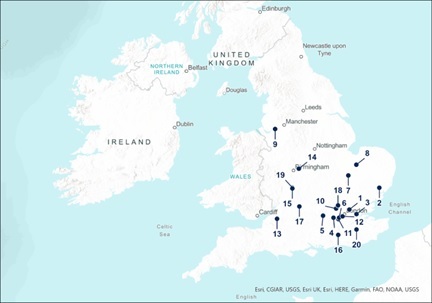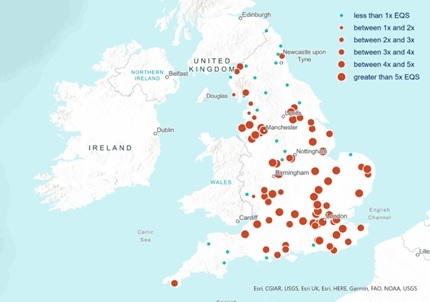28 February 2023
- At least 77% (81 out of 105) of English river sites where forever chemicals have been found would fail proposed new EU safety standards for surface water
- 42% (44 out of 105) of these river sites exceed proposed EU safe levels by more than 5 times.
- English forever chemical hotspots revealed with some rivers having 10 times or more PFAS than the proposed EU safe thresholds
- Official monitoring data only covers a handful of PFAS chemicals and not all rivers are tested, so actual pollution levels could be much worse
Environment experts are urging Government to lead the way on reducing chemical pollution in forthcoming UK Chemicals Strategy
Environment experts are warning that the UK is set to fall behind the EU in preventing toxic forever chemicals from polluting our rivers and ocean, adding to growing public concerns about water quality.
New analysis of official Environment Agency data for Wildlife and Countryside Link (England’s biggest nature coalition) by The Rivers Trust has revealed that many English river sites would fail new EU proposed safe levels for the per- and poly-fluoroalkyl substances (PFAS) group of forever chemicals in surface water.[1]
In English river sites where PFAS have been detected, at least 77% would fail to meet proposed EU standards (expected to be agreed this year). Of the sites that are exceeding, more than half of them are above the proposed threshold by 5 times or more. Some river sites including on the River Ouse in Bedfordshire, the River Avon in Somerset and the River Mersey in Cheshire have at least 10 times the EU’s proposed new safe level of PFAS forever chemicals, with the River Roding in East London having more than 20 times this amount (see table 1 for more details).
The EU is proposing stricter new standards on the levels of ‘forever chemicals’ that are deemed safe in rivers.[2] Crucially, the proposed new EU Environmental Quality Standard is set for a group of 24 different PFAS, rather than for individual PFAS, to protect people and wildlife from the cumulative effect from an exposure to chemical cocktails. Five EEA countries have also submitted a proposal to ban the use of around 10,000 PFAS in the EU, and there are EU commitments to adopt a grouping approach on chemical regulation.
The EU’s proposed crackdown aims to reduce PFAS pollution in our environment, reducing risks for wildlife, water and human health. Experts are urging the UK Government to deliver measures at least as strong as the EU proposals in its forthcoming UK Chemical Strategy.
Richard Benwell, CEO of Wildlife and Countryside Link, said: “‘Forever chemicals are a toxic timebomb, building up in our waters and wildlife - a risk for nature and public health. The government’s upcoming Chemicals Strategy and PFAS regulations are a critical opportunity to head off the threat.
"No programme to clean up British rivers would be complete without a plan to prevent PFAS pollution, which our research has found at levels which should ring alarm bells. The Government should ban unnecessary ‘forever chemical’ use in products like cosmetics and food packaging, tackle similar chemicals as a group, and set safety standards to prevent dangerous chemical cocktail effects in the environment.”
Dr Rob Collins, Director of Policy and Science at the Rivers Trust, said: “It is shocking that our research has revealed that our rivers can contain more than ten times the levels of PFAS that many scientists deem to be safe. But this could be just the tip of the iceburg, UK monitoring of PFAS is patchy at best and the full extent of forever chemical pollution could be even worse. Most forever chemicals aren’t even monitored, so levels could be even higher, which has worrying risks for the public and wildlife. We need properly-resourced monitoring and to turn off the PFAS pump at the source through much stricter controls, if we are to get the PFAS chemical cocktail in our rivers under control.”
Dr Julie Schneider, PFAS campaigner at CHEM Trust, said: “The more we learn about the harmful properties of PFAS, the more concerned we become. This is why authorities around the world are consistently bringing in more protective safety standards based on the most up to date science. PFAS pollution has been left to spiral out of control and it is not acceptable that the most persistent synthetic chemicals ever created are still allowed to be used so widely in our society.
“The Government must urgently turn off the PFAS tap to protect nature and our communities. And a good place to start would be to ban the use of PFAS in cosmetics, consumer textiles and food packaging. A sandwich bag does not need to be coated with PFAS.”
Per- and poly-fluoroalkyl substances (PFAS) are a group of thousands of human-made chemicals that are used mainly to make materials heat, water, flame or stain resistant. They are widely found as fire and stain-proofing in furniture and carpets, in non-stick products, paints, pesticides and pharmaceuticals, and are found in products from cosmetics to guitar strings. There is an increasing amount of evidence linking PFAS exposure to harmful impacts on wildlife and human health, including impact on the liver and immune system, and increasing risk of certain types of cancer.
It’s not just environmentalists who are calling for reductions in the use of PFAS chemicals, leading investors are also concerned and are urging businesses to rethink their use. In September 2022 47 investors managing a combined $8 trillion in assets, wrote to 54 of the world's biggest chemicals companies urging them to phase out forever chemicals. The investors, including Aviva Investors and Storebrand Asset Management, cited a range of risks, including an increased threat of litigation. Yet in its ChemScore annual non-profit industry tracker, Swedish charity ChemSec found just four companies had a plan to phase out hazardous chemicals from their portfolio.
In the UK PFAS monitoring is limited, with this new analysis showing that only 14 PFAS out of several thousands are screened for, with sampling patchy and inconsistent. UK monitoring equipment is also becoming outdated, as it is not sensitive enough to detect PFAS amounts at the levels the EU is proposing as safe. Improving the poor monitoring of PFAS and other chemicals and pollutants in our rivers would need a funding boost for the Environment Agency.
Environmentalists are urging Government to get tough on forever chemicals and the wider chemical cocktail in our environment in PFAS regulation, UK REACH and the UK Chemicals strategy by:
- Phasing out PFAS from all but the most vital uses.
- Regulating chemicals in groups (where all chemicals with similar structures would be restricted if one was found to be harmful. This would prevent one damaging chemical being easily replaced by another similar chemical).
- Addressing the chemical cocktail effect in our rivers and ocean, routinely monitoring for known dangerous combinations of cocktails and taking mixtures into account in chemical safety assessments for new chemicals to be put on the market.
- Delivering more rigorous monitoring, including through increased funding for the Environment Agency’s river monitoring programme.
Experts also urge that chemical protections are not weakened through the Retained EU Law Bill process, which currently gives the Government powers to amend or scrap key pieces of chemicals legislation. Instead, there is opportunity for the Government to exceed EU ambition on “forever chemicals” by, for example, leading the way on delivering a PFAS polluters levy, ensuring the industry contributes funds to tackle the PFAS they have produced.
Table 1: River sites with the greatest minimum annual average concentration of PFAS (2019-2022)Please note the concentration is in ug/l PFOA equivalent, and is based on the sum of detection limits of each PFAS detected at a given site with each value weighted with a PFOA relative potency factor. This is used as a proxy for minimal PFAS concentration at a given site in PFOA equivalent.

* DS = Downstream US = Upstream STW = Sewage Treatment Works
Map 1: Map of the top 20 sites with the greatest minimum annual average concentration

Map 2: Minimum concentration levels at sites with positive detections for the targeted EU PFAS substances (NB two sampling sites are not displayed due to a location error in the EA database)

ENDS
Notes to editors:
Chemical Fact file:
- The European Chemical Agency says without restrictions, levels of PFAS will be reached that have negative effects on people’s health and the environment, with authorities estimating 4.4 million tonnes of PFASs set to end up in the environment over the next 30 years unless action is taken.
- One of the largest PFAS manufacturers in the US - 3M- is facing up to $30bn in legal liabilities after being hit with thousands of litigations. This resulted in the company committing to discontinue to use of PFAS across its product portfolio by 2025.
- More than 70% of chemicals manufactured and used in Europe are hazardous to human health and/or the environment.
- According to the World Health Organization, two million lives and 53 million disability-adjusted life years were lost due to exposure to hazardous chemicals in 2019, compared to 1.6 million and 43 million in 2016.
1. The Rivers Trust analysis aimed to evaluate Environment Agency data on as many as possible of the 24 PFAS that are included in the EU’s proposed new combined Environmental Quality Standard for PFAS.
The Government’s Liquid chromatography-mass spectrometry (LC-MS) Target Screening Database, which screens individual water samples for a wide range of chemical compounds, was found to contain data on up to 14 of these chemicals.
Data from the Government’s Water Quality Archive was reviewed, but this held data on a very limited number of PFAS. Only data on 4 PFAS chemicals (PFOS, PFOA (perfluorooctanoate anion), PFOA (Perfluorooctanoic acid) and PFHxS-L) are detailed in this dataset. Due to differences in the analytical methods, direct comparisons between the LC-MS Target Screening Database and the Water Quality Archive are not recommended. So we were unable to combine this data into the more detailed LC-MS dataset.
The LC-MS data set details positive detections only, where concentrations were equal to or greater than the lower limit of detection. Where a chemical is scanned but not detected, there is no record of that chemical reported in the dataset. This means that we cannot provide statistics on the proportion of rivers where particular PFAS chemicals are found.
The LCMS does not quantify the concentration of PFAS substances found in surface water samples. It merely identifies that PFAS has been found at or above the limit of detection. All Rivers Trust calculations therefore use the limit for detection value as a proxy for the minimum concentration of a given PFAS at one site. Actual concentration of each PFAS detected at a given site could in fact be higher. The limit of detection for these chemicals ranges from 0.1 to 0.0001 µg/l.
The proposed EU Environmental Quality Standard in surface water is of 0.0044 µg/l PFOA equivalents for the sum of 24 PFAS.
For each sampling point we have taken an average concentration for each PFAS based on all detections between 2019 and 2022, with Relative Potency Factor values applied that would be used in the EU proposed standards.
Applying this methodology, even when assuming the lowest possible detectable concentration and with data for only 14 out of the 24 substances listed in the proposed EU standard, resulted in sample sites exceeding the proposed EU environmental quality standard.
2. In freshwater, the UK only stipulates a safe threshold for one type of “forever chemical”- PFOS. But the EU’s proposed new approach recognises that multiple (24) PFAS will be found at the same freshwater sites because there are currently multiple PFAS polluting water.



Latest Press Releases